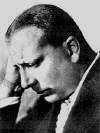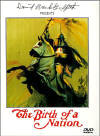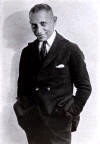
It Happened
in History!
(Go to
It Happened in History Archives)
|
When the German steamer, Prince Friedrich Wilhelm, arrived in New York harbor on November 25, 1909, the 24-year-old man who got off was named Erich Oswald Stroheim. By the time he entered the Immigration Office, he was Erich Oswald Hans Carl Maria von Stroheim, the son of a German Baroness and an Austrian Count and a decorated graduate from the Military Academy at Wienerneustadt. In reality, he was the son of Johanna and Benno Stroheim, a modest Jewish hat maker and manufacturer. Little did von Stroheim realize it then, but by the time he died, his life would be far more fascinating than anything he could ever have invented. Von Stroheim's first job in his new country was wrapping packages for the holidays at the Simpson-Crawford department store. Following that, he worked at a variety of menial jobs. He wanted to become a filmmaker, but he was forced to take employment as a traveling salesman for the Max Grab Fashion Company in order to survive. But problems with the company left von Stroheim stranded in San Francisco; and, in 1912, he began working at The West Point Inn, a tavern at the summit of Mount Tamalpais. While at the tavern, he met his first wife, Margaret Knox. They moved in together--a daring thing to do in those socially conservative Victorian times. Knox acted as a mentor to her new husband, teaching him language and literature and encouraging him to write. Under her watchful eye, he completed a novella entitled In the Morning. Its theme would resonate throughout his life: corrupt aristocracy meets debased innocence. Von Stroheim and Knox were married on February 19, 1913, but money problems left him depressed and angry. Often, he unleashed his anger on his wife. Not long afterwards, she left him and, in May 1914, filed for divorce.
Von Stroheim was impressed by Griffith's attention to detail, his insistence on character development, and his sense of realism--all things that would eventually make von Stroheim legendary in his own quest for a place in filmmaking history. But success was still a long way off. Following The Birth of A Nation, von Stroheim was back haunting the studios, eager for work. He took bit parts in Ghosts and The Failure, which brought him some notoriety. He won his first real part as the villain in Farewell to Thee, a part that he played lavishly.
After Old Heidelberg, von Stroheim accompanied Emerson to New York to assist with two more pictures, Douglas Fairbanks' His Picture in the Papers and Norma Talmadge's The Social Secretary. Returning to Hollywood, he continued to pick up bit parts. But by 1917, the actor's luck had run out. His on-screen portrayal of the evil German officer had caught up with him. With World War I in full swing, he found himself out of work and blacklisted, a victim of the simple-mindedness his own films had helped to create. People tied him to Germany's Kaiser Wilhelm and questioned his "Americanism." Around the same time, D.W. Griffith had returned to New York from France, carrying footage to complete a humanitarian film criticizing the war. Griffith wanted von Stroheim to direct the film, which the young German managed to pull off with more than a little box office success. Following the war, von Stroheim went to Universal in 1919. There he co-starred in The Heart of Humanity. "The Man You Love to Hate," as he had by now been dubbed, once again portrayed the heavy, displaying touches that later were to become his trademark. Particularly memorable is the rape scene where von Stroheim, irritated by the screams of the woman's baby, throws the child out the window. While at Universal, von Stroheim was obsessed with showing his screenplay, The Pinnacle, to studio head Carl Laemmle. The actor went so far as to camp out at Laemmle's home. The ploy worked, and von Stroheim was given the go-ahead to direct his script. It was renamed Blind Husbands and released in 1919 to good reviews. It was classic von Stroheim, with his sophisticated approach to sex and seduction in a Continental setting--themes and motifs that would follow him throughout his life.
But von Stroheim's dedication to detail nearly destroyed the production. Determined that the film's setting, Monte Carlo, be meticulously reproduced down to the most minute detail, the young director spent nearly one year and more than $1 million--an incredible amount of money for the time--filming the picture. Despite production and director problems, Foolish Wives was both a critical and a commercial success, and von Stroheim found himself sitting on top of the show business world. In 1923, Universal assigned him to another big-budget film, Merry-Go-Round. This time, when costs began escalating, von Stroheim was fired only five weeks into shooting.
Years later, when von Stroheim finally saw the edited version for the first time, he wept as he watched it. "This was like an exhumation for me," he said. "In a tiny coffin I found a lot of dust, a terrible smell, a little backbone and a shoulder bone." The movie is considered one of the greatest films ever made, something of a Holy Grail among film fans. At the time, however, its unrelenting view of the effects of greed on human nature proved too depressing for its pre-Depression Era 1925 audience, and the film was a resounding box-office flop. Von Stroheim was given a chance to atone when he was assigned to direct The Merry Widow, starring Mae Murray and John Gilbert. This time, his film was a success, with Murray gaining the best notices of her career. On the strength of that showing, von Stroheim was offered the opportunity to film another project, The Wedding March. Once again, though, the director's maniacal insistence on authenticity ended up getting him fired. In 1928, Gloria Swanson and her financial backer, a man named Joseph P. Kennedy, hired von Stroheim to direct a film for Swanson's own production company. The film, Queen Kelly, was written by von Stroheim and featured Swanson as an orphan who is seduced by the Queen's fiancee. As filming progressed, the storyline grew progressively darker--along with the atmosphere on the set. Finally, Swanson walked out and von Stroheim was again fired. The film was never completed. Queen Kelly was to be von Stroheim's last directorial effort. He was given a chance to film the 1932 story, Walking Down Broadway, but it, too, was never completed, and in 1936, the director left for France, leaving behind his third wife Valerie and sons Erich Jr. and Josef.
In 1950, von Stroheim returned to the United States to star in another Wilder picture, Sunset Boulevard, also starring Gloria Swanson, before returning to France to Maurepas, Seine-et-Oise, (now Yvelines, Īle-de-France), where he died of cancer on May 12.
Discover Erich von Stroheim
Indulge
Yourself - Check Out Today's Best-Selling |
- HOME -








